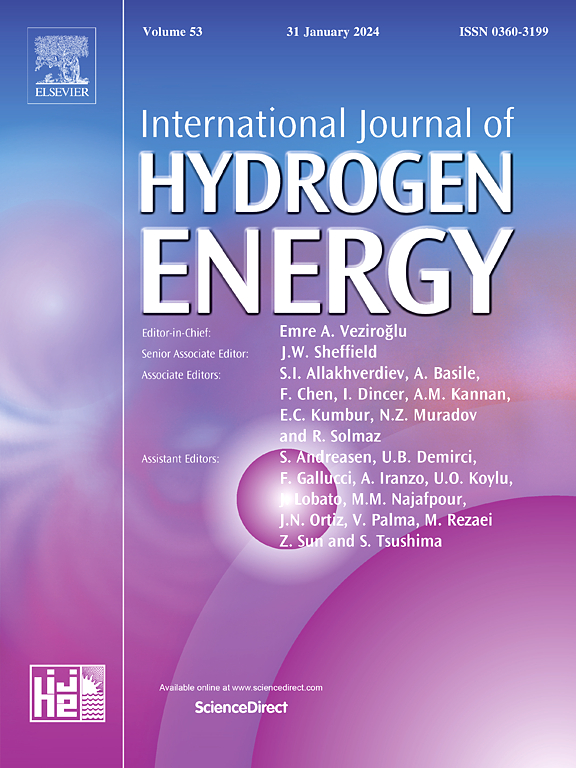Gold cluster decorated MoS2 monolayer for enhanced hydrogen evolution reaction: A DFT investigation
IF 8.1
2区 工程技术
Q1 CHEMISTRY, PHYSICAL
引用次数: 0
Abstract
2D MoS2 has emerged as a promising and cost-effective electrochemical catalyst. While the basal planes of 2D MoS2 are intrinsically inert for the hydrogen evolution reaction (HER), its overall activity can be improved by decorating the surface with small gold clusters. Here, we used dispersion-corrected density functional theory to systematically investigate the structural, electrical, and catalytic properties of gold atom clusters containing one to four atoms decorated on MoS2 monolayers (Aun@MoS2, n = 1–4). Our findings unveil that Aun@MoS2 systems are energetically stable, with negative binding energies. The decoration with Au clusters reduces the band gap, enhances charge transfer ability, and improves HER activity compared to pristine MoS2. Among the studied systems, Au3@MoS2 at all three Au sites and Au4@MoS2 at one Au site exhibited the best HER performance, with near-zero Gibbs free energy values for hydrogen adsorption. The HER activity trend suggests that while larger Aun clusters generally offer more active sites, Au3@MoS2 outperforms Au4@MoS2, emphasizing the role of suitable Au–Mo ratio and Au content. This study highlights Au3@MoS2 and Au4@MoS2 as stable and efficient catalysts for HER, offering a viable strategy to enhance the catalytic performance.

金簇修饰二硫化钼单层增强析氢反应的DFT研究
二维二硫化钼是一种极具发展前景和经济效益的电化学催化剂。虽然二维二硫化钼的基面对析氢反应(HER)本质上是惰性的,但通过用小的金团簇装饰表面可以提高其整体活性。在这里,我们使用分散校正的密度泛函理论系统地研究了在MoS2单层上装饰含有1到4个原子的金原子团簇的结构、电学和催化性能(Aun@MoS2, n = 1-4)。我们的发现揭示了Aun@MoS2系统是能量稳定的,具有负结合能。与原始的MoS2相比,Au团簇的修饰减小了带隙,增强了电荷转移能力,提高了HER活性。在所研究的体系中,三个Au位点的Au3@MoS2和一个Au位点的Au4@MoS2表现出最好的HER性能,其吸附氢的吉布斯自由能值接近于零。HER活性趋势表明,虽然较大的Au簇通常提供更多的活性位点,但Au3@MoS2优于Au4@MoS2,强调了合适的Au - mo比和Au含量的作用。本研究强调Au3@MoS2和Au4@MoS2是稳定高效的HER催化剂,为提高HER的催化性能提供了可行的策略。
本文章由计算机程序翻译,如有差异,请以英文原文为准。
求助全文
约1分钟内获得全文
求助全文
来源期刊

International Journal of Hydrogen Energy
工程技术-环境科学
CiteScore
13.50
自引率
25.00%
发文量
3502
审稿时长
60 days
期刊介绍:
The objective of the International Journal of Hydrogen Energy is to facilitate the exchange of new ideas, technological advancements, and research findings in the field of Hydrogen Energy among scientists and engineers worldwide. This journal showcases original research, both analytical and experimental, covering various aspects of Hydrogen Energy. These include production, storage, transmission, utilization, enabling technologies, environmental impact, economic considerations, and global perspectives on hydrogen and its carriers such as NH3, CH4, alcohols, etc.
The utilization aspect encompasses various methods such as thermochemical (combustion), photochemical, electrochemical (fuel cells), and nuclear conversion of hydrogen, hydrogen isotopes, and hydrogen carriers into thermal, mechanical, and electrical energies. The applications of these energies can be found in transportation (including aerospace), industrial, commercial, and residential sectors.
 求助内容:
求助内容: 应助结果提醒方式:
应助结果提醒方式:


